Journaling is a powerful yet often underused tool in language learning. It encourages regular practice, builds vocabulary, and helps learners internalize grammar rules through real-life expression. Whether you’re a beginner or advancing your skills, journaling can become a daily habit that boosts fluency, confidence, and creativity.
1. Start with Simple Daily Entries
Begin by writing about your day in the target language. Use basic sentences to describe what you did, how you felt, and what you plan to do tomorrow. This reinforces common vocabulary and sentence structure in a personal context.
2. Use Prompts to Spark Ideas
If you’re not sure what to write, use prompts like:
- What did I enjoy today?
- What’s one new word I learned?
- Describe your favorite meal or place.
These questions encourage variety in vocabulary and help develop descriptive language.
3. Keep a Vocabulary Log
As you write, make note of unfamiliar words you had to look up. Create a list at the end of each journal entry and revisit it regularly. This personalized word bank strengthens long-term retention.
4. Focus on Progress, Not Perfection
Don’t worry about perfect grammar or spelling. The goal is to practice freely. Over time, patterns will emerge, and your writing will naturally become more accurate.
5. Combine With Reading and Listening
Read articles, books, or listen to podcasts, then write journal reflections about what you learned or thought. This integration of skills reinforces understanding and encourages active use of new language.
6. Use Apps or Physical Journals
Digital journaling tools like Google Docs, journaling apps, or language learning platforms with writing features offer convenience and accessibility. If you prefer paper, a dedicated notebook creates a tactile, focused environment.
7. Revisit Old Entries
Reading past journal entries helps you see how far you’ve come. Correcting past mistakes or rewriting older entries with improved language can reinforce growth and encourage reflection.
Conclusion
Journaling in your target language turns passive knowledge into active skill. It allows for consistent, low-pressure practice that strengthens vocabulary, grammar, and self-expression. Whether for five minutes a day or once a week, this simple habit can become a cornerstone of your language learning journey.














